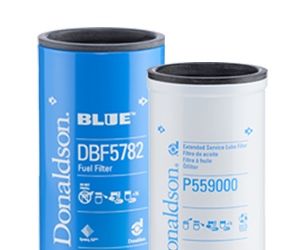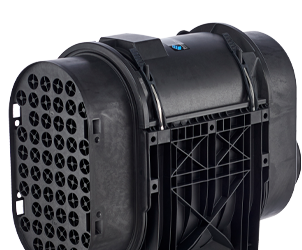Overview
Filtration Media Offers Critical Protection
The heart of any filter is the media inside. Filtration media is the most critical component in any filter. It determines whether filters offer protection – or create problems. Since our inception in 1915, Donaldson has focused on mastering the science of filtration media. When it comes to fuel filtration, this focus has never been more important.
Modern high pressure common rail (HPCR) injectors operate at pressures up to 30,000–45,000 psi / 2,000–3,100 bar. At those pressures, even the tiniest hard particulate or the smallest amount of water contamination can cause serious damage to a system. Fuel must be cleaner and drier than ever before to ensure that highly engineered and microscopically precise fuel-system pumps and injectors are able to perform at the highest levels.
Fuel filtration at this level has many facets. When designing filtration media, you need to optimize performance for both efficiency of contaminant removal and capacity / pressure drop, because both impact filter life and effectiveness. In addition to contaminant control, effective filtration needs to remove water at consistently a high level over the life of the filter.
When Donaldson designs media for fuel filtration, we develop innovative strategies and technologies that support these facets and more.

Filter Media Design and Development
From traditional cellulose to synthetic, the development of proprietary filtration substrates is at the heart of every Donaldson filtration system. If our existing media formulations don't meet our customers' specifications, our scientists and engineers use our in-house media development laboratories and proprietary design tools and processes to create bleeding-edge new formulations to meet those specific needs.

An Efficient Process for Efficient Filtration
Our efforts to perfect filtration media have let us to go beyond media development. The need for ever-evolving filtration media has caused us to develop many proprietary computer models which enable us to predict media performance for a given fiber mixture, initial pressure loss for filter elements of various configurations, and filter loading with many different contaminants. This enables us to quickly work through many design concepts to optimize the filtration system for a unique application.

Development, Testing and Analysis
Donaldson has pioneered a wide range of engineering, design and testing tools used during the product development and validation process. We strive to meet or exceed customer requirements, even if we have to create entirely new processes to do so. We create the technology that creates the technology. And that makes our development process as efficient as our filtration.
Primary Filtration
Water and Fuel Separation Media for Primary Filtration
Water in fuel is a bigger threat than ever before. Today’s high-pressure common rail fuel systems are extremely sensitive to any water in fuel. At the same time, biodiesel blends and large amounts of additives in today’s Ultra Low Sulfur Diesel (ULSD) make removing water much more difficult.
In addition to more challenging fuel conditions, fuel injector manufacturers now state that little to no water must reach HPCR injectors. Failure to do so can result in injector failures from rust or corrosion that result in costly repairs and downtime.
Donaldson offers two types of fuel water removal technologies:
Coalescing Fuel Water Separators: Coalescing technology uses a multi-stage approach to coalesce and remove water from fuel. This process removes more water than traditional barrier filters, particularly under today’s challenging fuel conditions, and performs consistently for the entire life of the filter.
Barrier Fuel Water Separators: Traditional barrier technology is commonly used today and utilizes a pleated media that creates a hydrophobic barrier to remove water from fuel. While barrier filters can be effective in protecting fuel systems, they are susceptible to performance degradation over time and under challenging operating and fuel conditions.
Coalescing Fuel Water Separator Solutions
Synteq™ DRY Coalescing Technology
This is our most advanced coalescing technology and is focused on delivering industry-leading end-of-life performance under the most severe fuel and operating conditions.
Coalescing filters are a major upgrade from barrier-style filters, removing more water throughout the life of the filter. While they are an improvement, end-of-life performance can be affected by difficult fuel and operating conditions. Testing shows that even the best coalescing filters in the industry today operate at around 35% water removal efficiency when nearing end-of-life.
Donaldson Synteq DRY coalescing technology performs much better, maintaining an industry-leading 80% to 90% water removal efficiency through the end of filter life, under the most severe fuel and operating conditions. Field data shows that this advanced coalescing solution removes significantly more water than current barrier or coalescing filters, providing greater protection for your equipment.
Synteq XP™ Coalescing Technology
Our first-generation coalescing technology, thanks to its industry leading performance, removes significantly more water than barrier filters and most coalescing filters on the market.
Tests show that while barrier style filters perform well after initial installation, water removal efficiency degrades over time, and can actually approach zero efficiency at end of life.
Synteq XP coalescing technology maintains a much higher level of water removal under the most severe operating conditions, making this an excellent upgrade to protect your high-pressure common rail fuel systems.
Barrier Style Fuel Water Separator Solutions
Synteq™ Synthetic Media

Donaldson’s Synteq fuel filter water separator media uses both a cellulose and synthetic layer the achieve effective fuel water separator performance. This media is used on the suction side of the fuel system to remove harmful water and solid contamination. Water is repelled by the media and drains to the bottom of the filter or water collection bowl. The solid contaminant is also trapped and held in the filter media.
Synteq synthetic media is an upgrade over standard cellulose media as it offers higher efficiency and increased dirt holding capacity for longer filter life.
Cellulose Media

This fuel filter water separator media is a treated cellulose base material. Treating a cellulose media with a silicone-based substance allows for effective water separation. This media is used on the suction side of the fuel system to remove harmful water and solid contamination. Water is repelled by the media and drains to the bottom of the filter or water collection bowl and solid contaminant is trapped in the filter media.
Secondary Filtration
Particulate Removal Media for Secondary Filtration
Secondary fuel filters are the last line of defense when it comes to protecting the highly sensitive – and highly expensive – components of today’s high-pressure common rail fuel systems.
Mounted between the transfer pump and the injectors, these filters need to capture very fine levels of particulate contamination in order to prevent damage to highly sensitive components like pumps and injectors. Secondary filters operate under much higher pressures than primary fuel filters, and capture contaminants you often can’t see with the naked eye.
Synteq XP™ Synthetic Media

Our high-performance Synteq XP media was developed specifically to overcome the broad range of challenges in today’s fuels. This groundbreaking filter media takes fuel filtration performance to a higher level by providing enhanced engine and system component protection; including:
- Higher-efficiency contaminant capture for optimal engine protection
- Filter life up to 3 times that of traditional filter media
Donaldson secondary fuel filters with Synteq XP fine-fiber media offer best-in-class contaminant capture. Tests have proven that they deliver fuel that is four times cleaner than competitors' best filters. Donaldson secondary fuel filters with Synteq XP media deliver:
- Best capture and retention of injector-damaging contaminants
- Best performance in heavy-duty environments (inferior filters can “slough” contaminant during engine vibration)
- Best protection for today’s sophisticated HPCR injectors
Synteq XP media uses fine fibers with resin-free fiber bonding which allows the filters to do what filters are intended to do – remove and retain more injector-damaging contaminant. Versatile and smaller filter packaging configuration options are available for secondary fuel filtration.
Cellulose Media

This traditional fuel filter media is most commonly a pleated cellulose base material. This media is tested for compatibility with a variety of diesel fuels, including biodiesel and ULSD. Larger particulates are trapped on the outer surface, while finer particles are captured deeper in the media.
Articles
Resources
Videos






